Analysis of Change Management Failures in Corporate Settings Essay
VerifiedAdded on 2023/06/10
|7
|1844
|148
Essay
AI Summary
This essay analyzes the primary reasons behind the failures of corporate change efforts, drawing from the work of John P. Kotter. It identifies key factors contributing to these failures, including the absence of a strong sense of urgency, the lack of a robust guiding coalition, the absence of a clear vision, and the failure to strategically plan for and achieve short-term wins. The essay elaborates on how these elements undermine transformation processes, referencing real-world examples from companies like Ford and General Motors. The paper emphasizes the importance of each phase in the change process and how skipping steps leads to unsatisfactory outcomes. By highlighting the critical roles of leadership, communication, and strategic planning, the essay provides a comprehensive understanding of the challenges and complexities involved in successful organizational change.
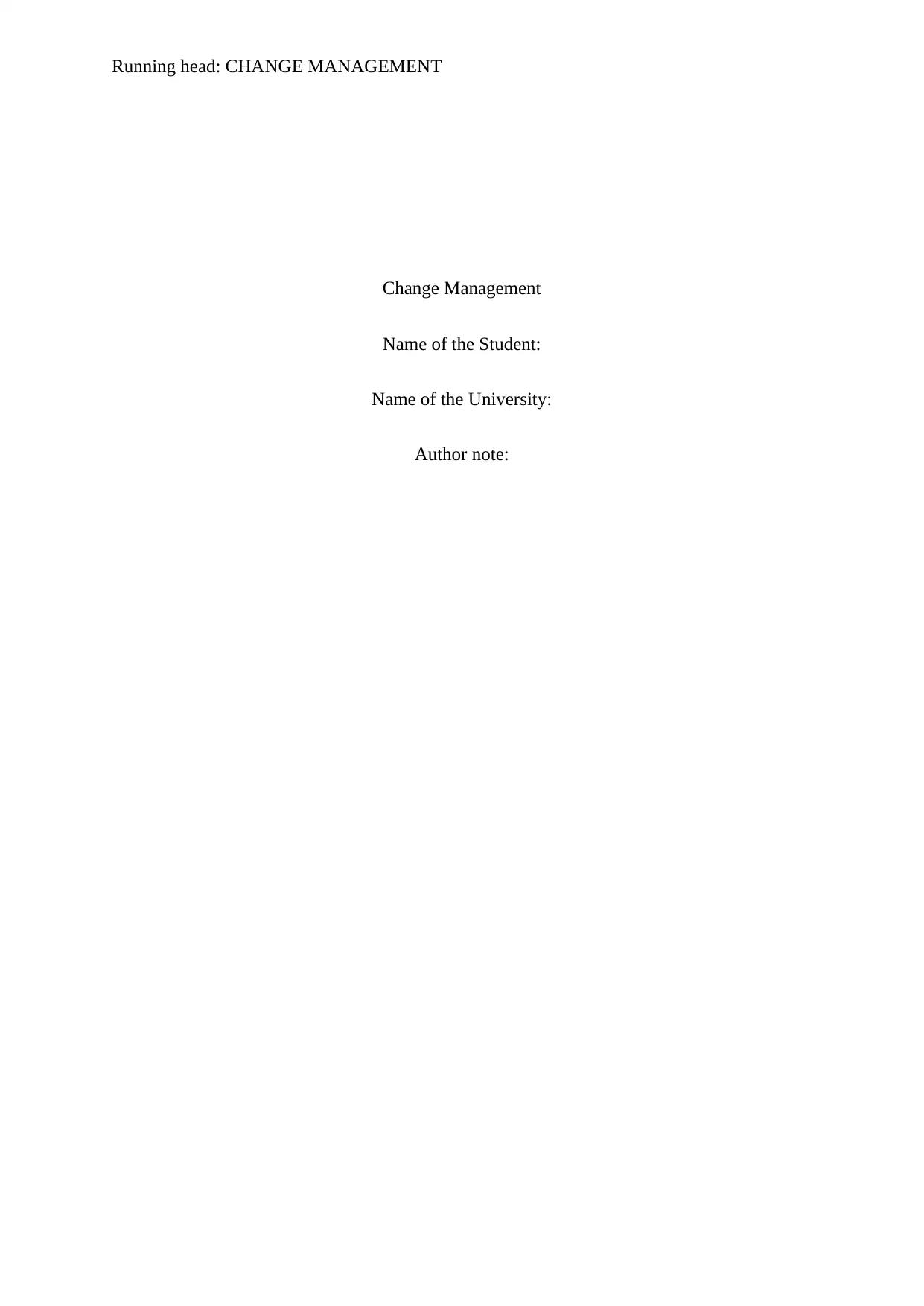
Running head: CHANGE MANAGEMENT
Change Management
Name of the Student:
Name of the University:
Author note:
Change Management
Name of the Student:
Name of the University:
Author note:
Paraphrase This Document
Need a fresh take? Get an instant paraphrase of this document with our AI Paraphraser
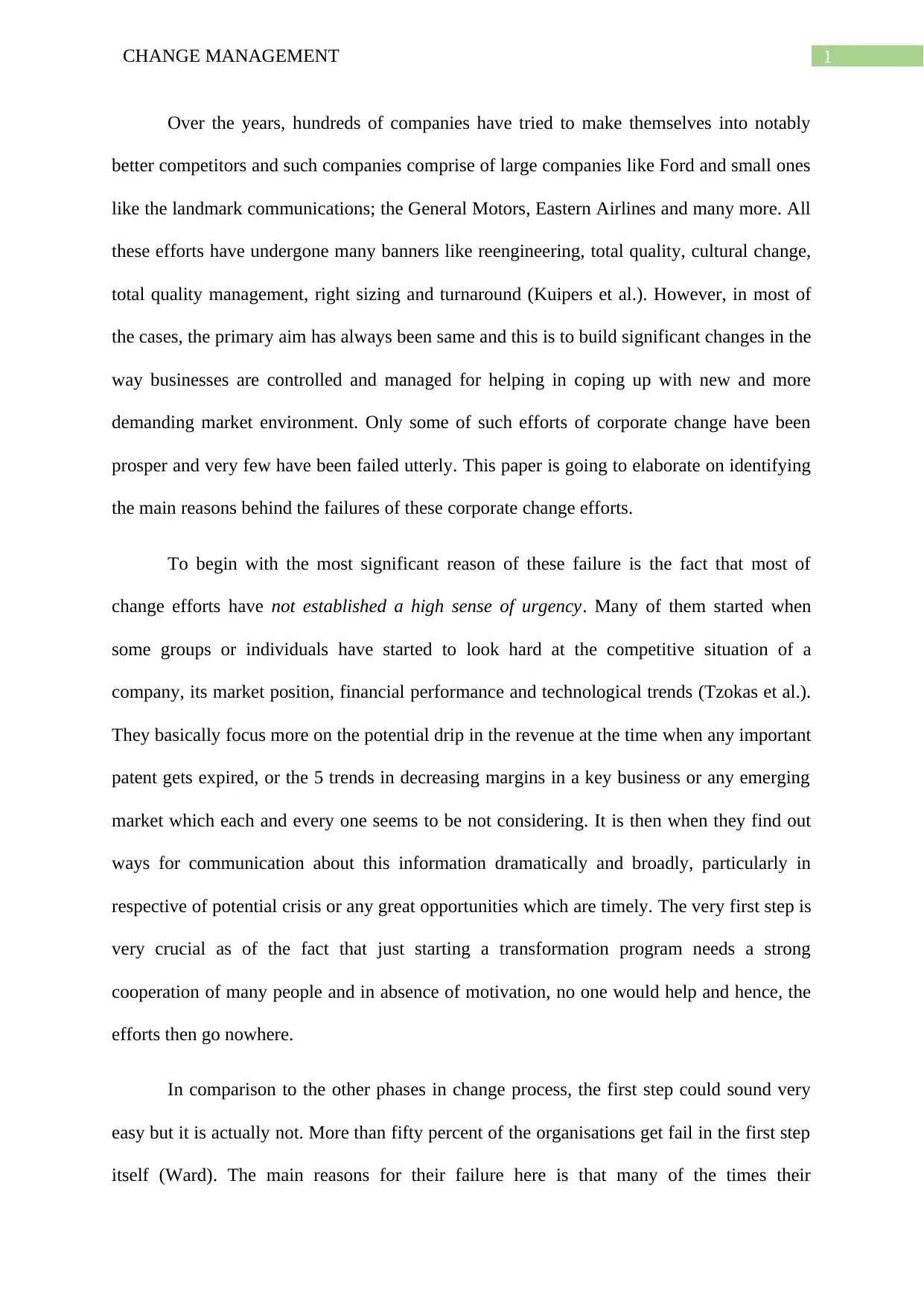
1CHANGE MANAGEMENT
Over the years, hundreds of companies have tried to make themselves into notably
better competitors and such companies comprise of large companies like Ford and small ones
like the landmark communications; the General Motors, Eastern Airlines and many more. All
these efforts have undergone many banners like reengineering, total quality, cultural change,
total quality management, right sizing and turnaround (Kuipers et al.). However, in most of
the cases, the primary aim has always been same and this is to build significant changes in the
way businesses are controlled and managed for helping in coping up with new and more
demanding market environment. Only some of such efforts of corporate change have been
prosper and very few have been failed utterly. This paper is going to elaborate on identifying
the main reasons behind the failures of these corporate change efforts.
To begin with the most significant reason of these failure is the fact that most of
change efforts have not established a high sense of urgency. Many of them started when
some groups or individuals have started to look hard at the competitive situation of a
company, its market position, financial performance and technological trends (Tzokas et al.).
They basically focus more on the potential drip in the revenue at the time when any important
patent gets expired, or the 5 trends in decreasing margins in a key business or any emerging
market which each and every one seems to be not considering. It is then when they find out
ways for communication about this information dramatically and broadly, particularly in
respective of potential crisis or any great opportunities which are timely. The very first step is
very crucial as of the fact that just starting a transformation program needs a strong
cooperation of many people and in absence of motivation, no one would help and hence, the
efforts then go nowhere.
In comparison to the other phases in change process, the first step could sound very
easy but it is actually not. More than fifty percent of the organisations get fail in the first step
itself (Ward). The main reasons for their failure here is that many of the times their
Over the years, hundreds of companies have tried to make themselves into notably
better competitors and such companies comprise of large companies like Ford and small ones
like the landmark communications; the General Motors, Eastern Airlines and many more. All
these efforts have undergone many banners like reengineering, total quality, cultural change,
total quality management, right sizing and turnaround (Kuipers et al.). However, in most of
the cases, the primary aim has always been same and this is to build significant changes in the
way businesses are controlled and managed for helping in coping up with new and more
demanding market environment. Only some of such efforts of corporate change have been
prosper and very few have been failed utterly. This paper is going to elaborate on identifying
the main reasons behind the failures of these corporate change efforts.
To begin with the most significant reason of these failure is the fact that most of
change efforts have not established a high sense of urgency. Many of them started when
some groups or individuals have started to look hard at the competitive situation of a
company, its market position, financial performance and technological trends (Tzokas et al.).
They basically focus more on the potential drip in the revenue at the time when any important
patent gets expired, or the 5 trends in decreasing margins in a key business or any emerging
market which each and every one seems to be not considering. It is then when they find out
ways for communication about this information dramatically and broadly, particularly in
respective of potential crisis or any great opportunities which are timely. The very first step is
very crucial as of the fact that just starting a transformation program needs a strong
cooperation of many people and in absence of motivation, no one would help and hence, the
efforts then go nowhere.
In comparison to the other phases in change process, the first step could sound very
easy but it is actually not. More than fifty percent of the organisations get fail in the first step
itself (Ward). The main reasons for their failure here is that many of the times their
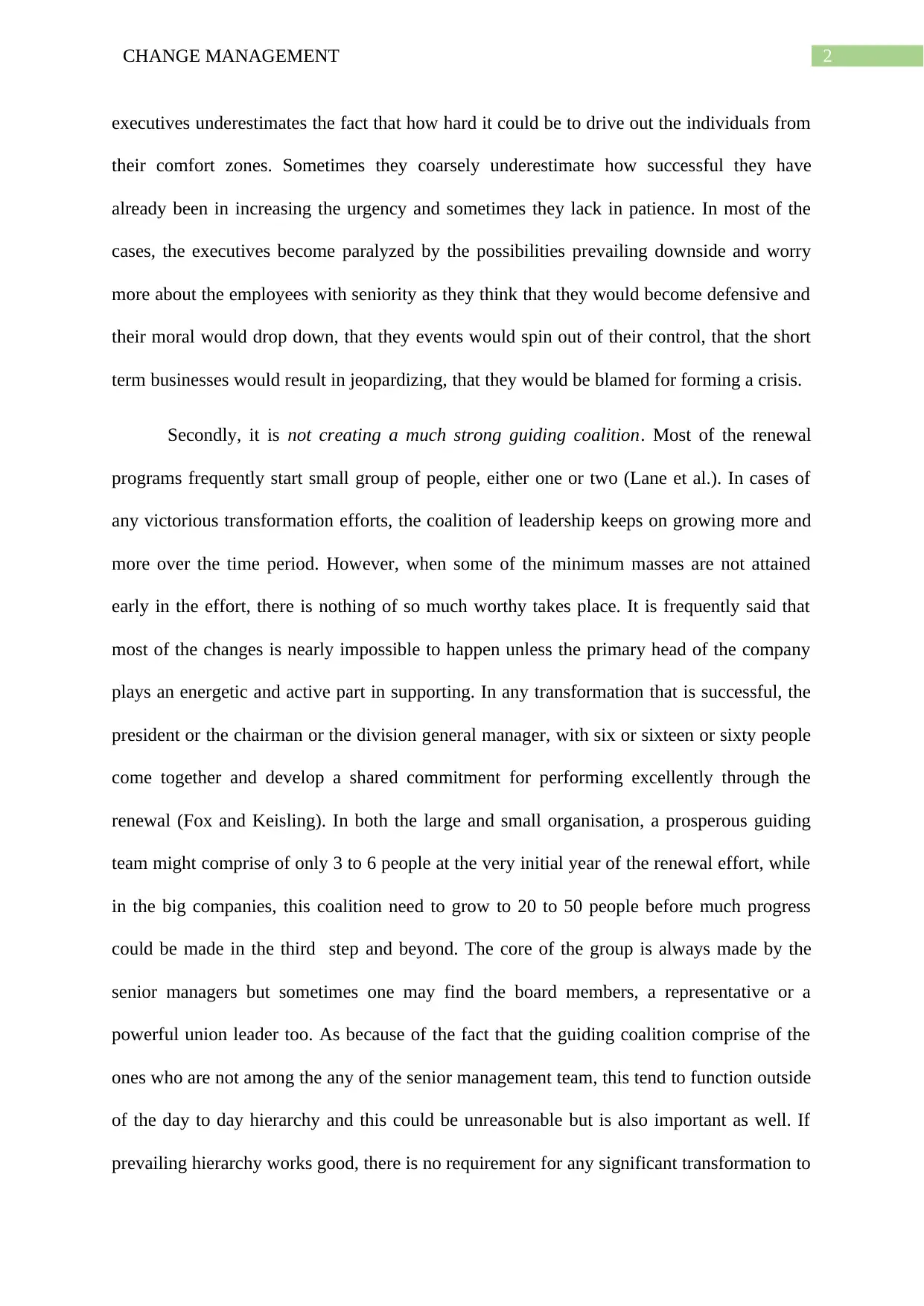
2CHANGE MANAGEMENT
executives underestimates the fact that how hard it could be to drive out the individuals from
their comfort zones. Sometimes they coarsely underestimate how successful they have
already been in increasing the urgency and sometimes they lack in patience. In most of the
cases, the executives become paralyzed by the possibilities prevailing downside and worry
more about the employees with seniority as they think that they would become defensive and
their moral would drop down, that they events would spin out of their control, that the short
term businesses would result in jeopardizing, that they would be blamed for forming a crisis.
Secondly, it is not creating a much strong guiding coalition. Most of the renewal
programs frequently start small group of people, either one or two (Lane et al.). In cases of
any victorious transformation efforts, the coalition of leadership keeps on growing more and
more over the time period. However, when some of the minimum masses are not attained
early in the effort, there is nothing of so much worthy takes place. It is frequently said that
most of the changes is nearly impossible to happen unless the primary head of the company
plays an energetic and active part in supporting. In any transformation that is successful, the
president or the chairman or the division general manager, with six or sixteen or sixty people
come together and develop a shared commitment for performing excellently through the
renewal (Fox and Keisling). In both the large and small organisation, a prosperous guiding
team might comprise of only 3 to 6 people at the very initial year of the renewal effort, while
in the big companies, this coalition need to grow to 20 to 50 people before much progress
could be made in the third step and beyond. The core of the group is always made by the
senior managers but sometimes one may find the board members, a representative or a
powerful union leader too. As because of the fact that the guiding coalition comprise of the
ones who are not among the any of the senior management team, this tend to function outside
of the day to day hierarchy and this could be unreasonable but is also important as well. If
prevailing hierarchy works good, there is no requirement for any significant transformation to
executives underestimates the fact that how hard it could be to drive out the individuals from
their comfort zones. Sometimes they coarsely underestimate how successful they have
already been in increasing the urgency and sometimes they lack in patience. In most of the
cases, the executives become paralyzed by the possibilities prevailing downside and worry
more about the employees with seniority as they think that they would become defensive and
their moral would drop down, that they events would spin out of their control, that the short
term businesses would result in jeopardizing, that they would be blamed for forming a crisis.
Secondly, it is not creating a much strong guiding coalition. Most of the renewal
programs frequently start small group of people, either one or two (Lane et al.). In cases of
any victorious transformation efforts, the coalition of leadership keeps on growing more and
more over the time period. However, when some of the minimum masses are not attained
early in the effort, there is nothing of so much worthy takes place. It is frequently said that
most of the changes is nearly impossible to happen unless the primary head of the company
plays an energetic and active part in supporting. In any transformation that is successful, the
president or the chairman or the division general manager, with six or sixteen or sixty people
come together and develop a shared commitment for performing excellently through the
renewal (Fox and Keisling). In both the large and small organisation, a prosperous guiding
team might comprise of only 3 to 6 people at the very initial year of the renewal effort, while
in the big companies, this coalition need to grow to 20 to 50 people before much progress
could be made in the third step and beyond. The core of the group is always made by the
senior managers but sometimes one may find the board members, a representative or a
powerful union leader too. As because of the fact that the guiding coalition comprise of the
ones who are not among the any of the senior management team, this tend to function outside
of the day to day hierarchy and this could be unreasonable but is also important as well. If
prevailing hierarchy works good, there is no requirement for any significant transformation to
⊘ This is a preview!⊘
Do you want full access?
Subscribe today to unlock all pages.

Trusted by 1+ million students worldwide
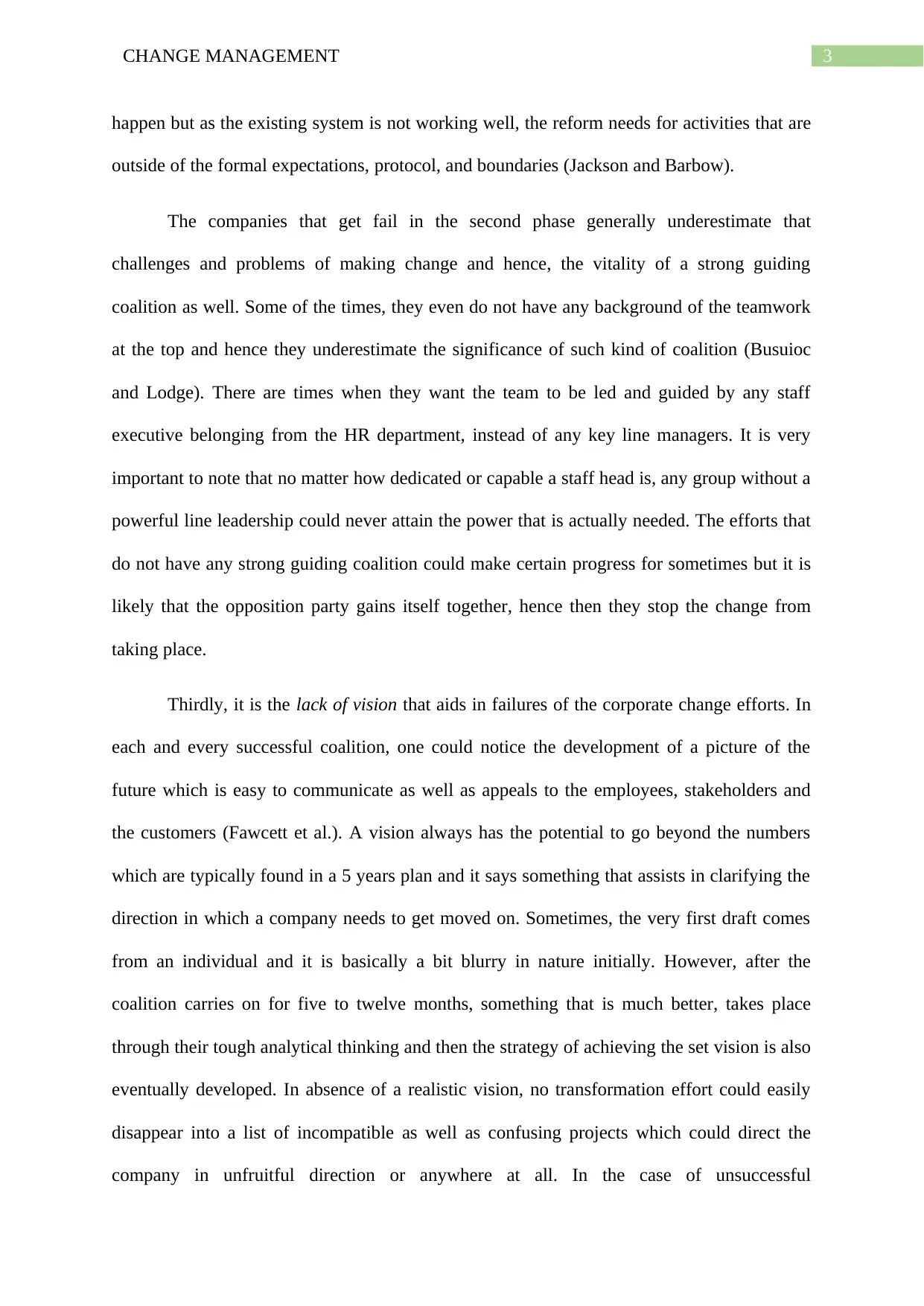
3CHANGE MANAGEMENT
happen but as the existing system is not working well, the reform needs for activities that are
outside of the formal expectations, protocol, and boundaries (Jackson and Barbow).
The companies that get fail in the second phase generally underestimate that
challenges and problems of making change and hence, the vitality of a strong guiding
coalition as well. Some of the times, they even do not have any background of the teamwork
at the top and hence they underestimate the significance of such kind of coalition (Busuioc
and Lodge). There are times when they want the team to be led and guided by any staff
executive belonging from the HR department, instead of any key line managers. It is very
important to note that no matter how dedicated or capable a staff head is, any group without a
powerful line leadership could never attain the power that is actually needed. The efforts that
do not have any strong guiding coalition could make certain progress for sometimes but it is
likely that the opposition party gains itself together, hence then they stop the change from
taking place.
Thirdly, it is the lack of vision that aids in failures of the corporate change efforts. In
each and every successful coalition, one could notice the development of a picture of the
future which is easy to communicate as well as appeals to the employees, stakeholders and
the customers (Fawcett et al.). A vision always has the potential to go beyond the numbers
which are typically found in a 5 years plan and it says something that assists in clarifying the
direction in which a company needs to get moved on. Sometimes, the very first draft comes
from an individual and it is basically a bit blurry in nature initially. However, after the
coalition carries on for five to twelve months, something that is much better, takes place
through their tough analytical thinking and then the strategy of achieving the set vision is also
eventually developed. In absence of a realistic vision, no transformation effort could easily
disappear into a list of incompatible as well as confusing projects which could direct the
company in unfruitful direction or anywhere at all. In the case of unsuccessful
happen but as the existing system is not working well, the reform needs for activities that are
outside of the formal expectations, protocol, and boundaries (Jackson and Barbow).
The companies that get fail in the second phase generally underestimate that
challenges and problems of making change and hence, the vitality of a strong guiding
coalition as well. Some of the times, they even do not have any background of the teamwork
at the top and hence they underestimate the significance of such kind of coalition (Busuioc
and Lodge). There are times when they want the team to be led and guided by any staff
executive belonging from the HR department, instead of any key line managers. It is very
important to note that no matter how dedicated or capable a staff head is, any group without a
powerful line leadership could never attain the power that is actually needed. The efforts that
do not have any strong guiding coalition could make certain progress for sometimes but it is
likely that the opposition party gains itself together, hence then they stop the change from
taking place.
Thirdly, it is the lack of vision that aids in failures of the corporate change efforts. In
each and every successful coalition, one could notice the development of a picture of the
future which is easy to communicate as well as appeals to the employees, stakeholders and
the customers (Fawcett et al.). A vision always has the potential to go beyond the numbers
which are typically found in a 5 years plan and it says something that assists in clarifying the
direction in which a company needs to get moved on. Sometimes, the very first draft comes
from an individual and it is basically a bit blurry in nature initially. However, after the
coalition carries on for five to twelve months, something that is much better, takes place
through their tough analytical thinking and then the strategy of achieving the set vision is also
eventually developed. In absence of a realistic vision, no transformation effort could easily
disappear into a list of incompatible as well as confusing projects which could direct the
company in unfruitful direction or anywhere at all. In the case of unsuccessful
Paraphrase This Document
Need a fresh take? Get an instant paraphrase of this document with our AI Paraphraser
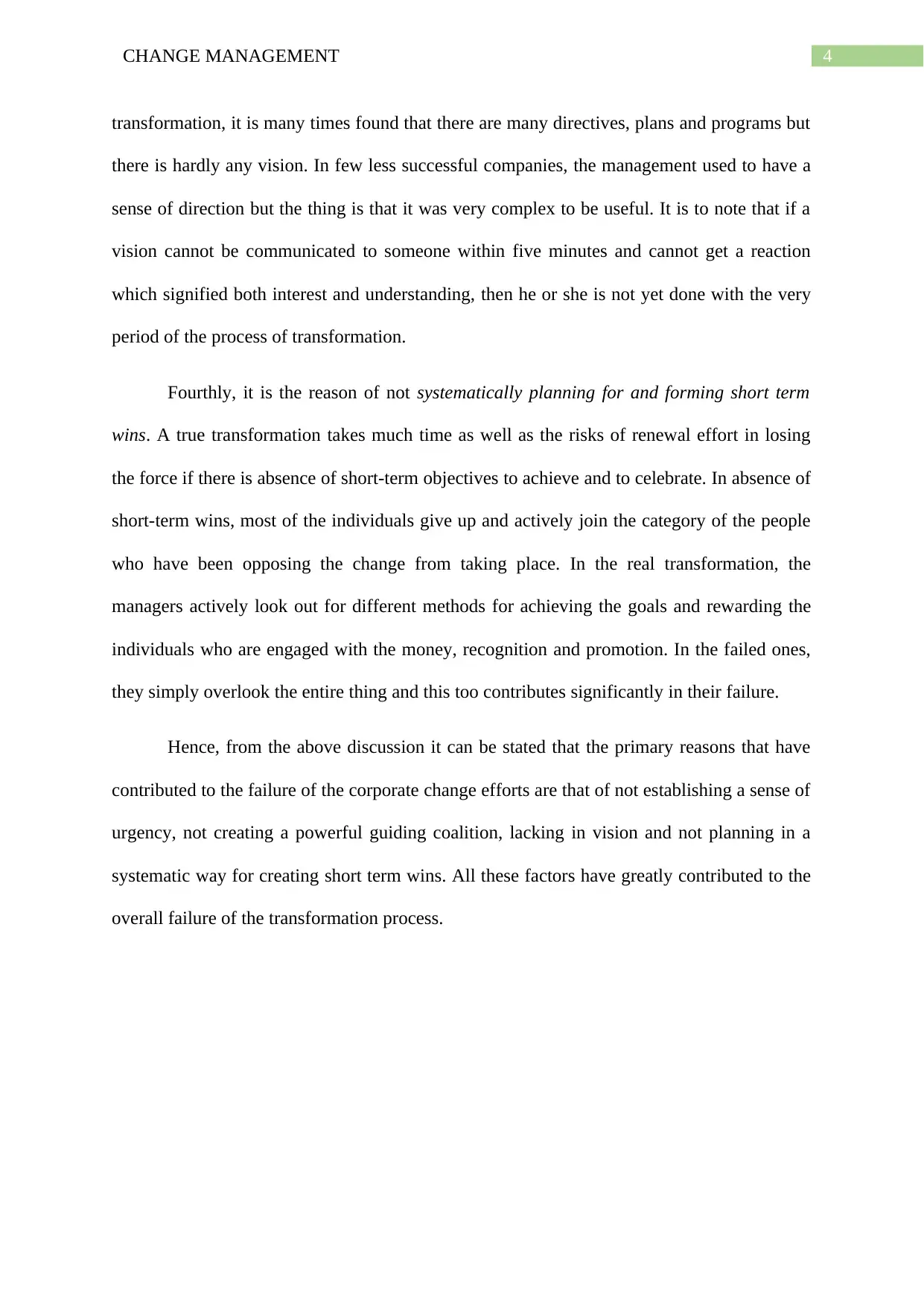
4CHANGE MANAGEMENT
transformation, it is many times found that there are many directives, plans and programs but
there is hardly any vision. In few less successful companies, the management used to have a
sense of direction but the thing is that it was very complex to be useful. It is to note that if a
vision cannot be communicated to someone within five minutes and cannot get a reaction
which signified both interest and understanding, then he or she is not yet done with the very
period of the process of transformation.
Fourthly, it is the reason of not systematically planning for and forming short term
wins. A true transformation takes much time as well as the risks of renewal effort in losing
the force if there is absence of short-term objectives to achieve and to celebrate. In absence of
short-term wins, most of the individuals give up and actively join the category of the people
who have been opposing the change from taking place. In the real transformation, the
managers actively look out for different methods for achieving the goals and rewarding the
individuals who are engaged with the money, recognition and promotion. In the failed ones,
they simply overlook the entire thing and this too contributes significantly in their failure.
Hence, from the above discussion it can be stated that the primary reasons that have
contributed to the failure of the corporate change efforts are that of not establishing a sense of
urgency, not creating a powerful guiding coalition, lacking in vision and not planning in a
systematic way for creating short term wins. All these factors have greatly contributed to the
overall failure of the transformation process.
transformation, it is many times found that there are many directives, plans and programs but
there is hardly any vision. In few less successful companies, the management used to have a
sense of direction but the thing is that it was very complex to be useful. It is to note that if a
vision cannot be communicated to someone within five minutes and cannot get a reaction
which signified both interest and understanding, then he or she is not yet done with the very
period of the process of transformation.
Fourthly, it is the reason of not systematically planning for and forming short term
wins. A true transformation takes much time as well as the risks of renewal effort in losing
the force if there is absence of short-term objectives to achieve and to celebrate. In absence of
short-term wins, most of the individuals give up and actively join the category of the people
who have been opposing the change from taking place. In the real transformation, the
managers actively look out for different methods for achieving the goals and rewarding the
individuals who are engaged with the money, recognition and promotion. In the failed ones,
they simply overlook the entire thing and this too contributes significantly in their failure.
Hence, from the above discussion it can be stated that the primary reasons that have
contributed to the failure of the corporate change efforts are that of not establishing a sense of
urgency, not creating a powerful guiding coalition, lacking in vision and not planning in a
systematic way for creating short term wins. All these factors have greatly contributed to the
overall failure of the transformation process.
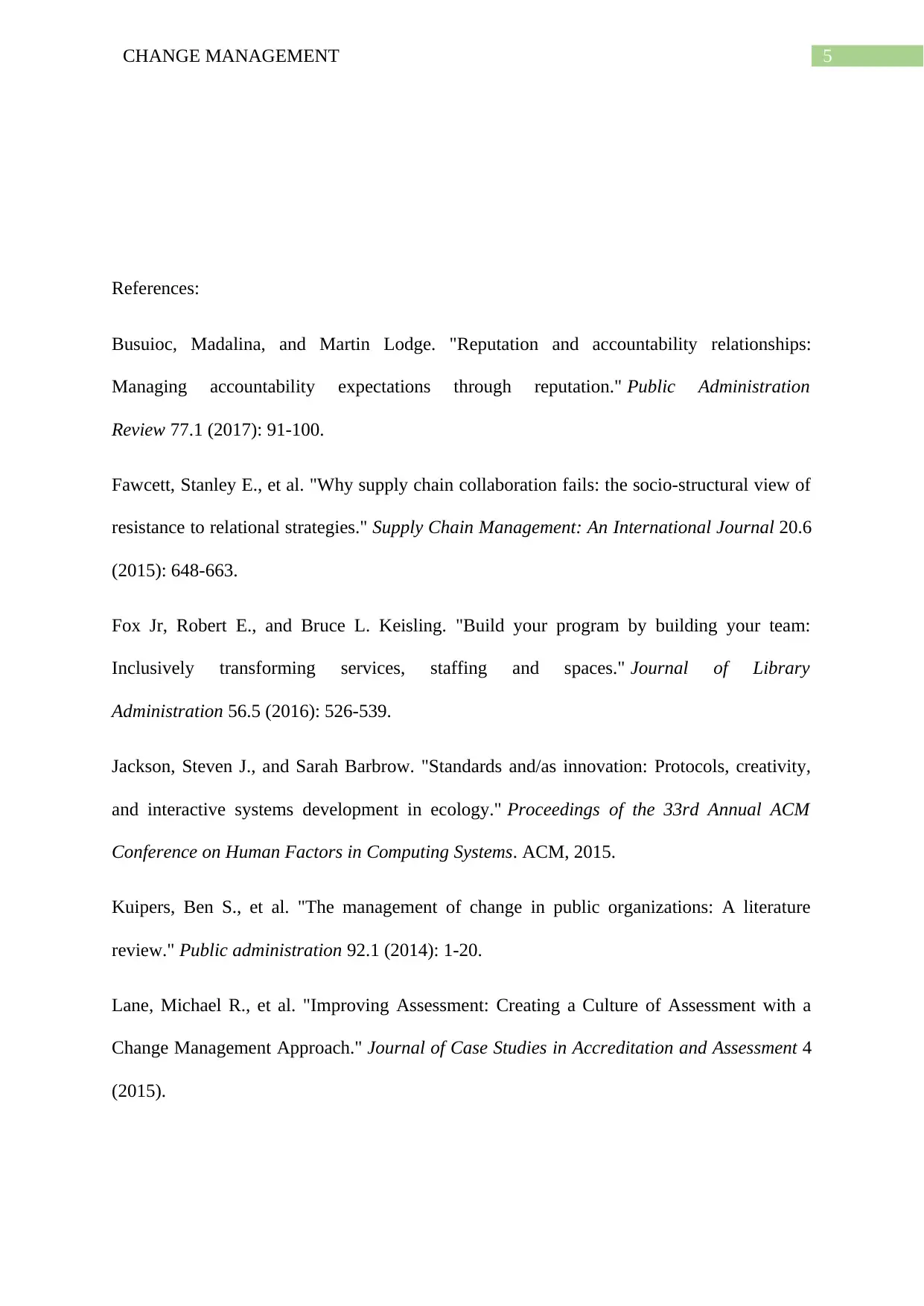
5CHANGE MANAGEMENT
References:
Busuioc, Madalina, and Martin Lodge. "Reputation and accountability relationships:
Managing accountability expectations through reputation." Public Administration
Review 77.1 (2017): 91-100.
Fawcett, Stanley E., et al. "Why supply chain collaboration fails: the socio-structural view of
resistance to relational strategies." Supply Chain Management: An International Journal 20.6
(2015): 648-663.
Fox Jr, Robert E., and Bruce L. Keisling. "Build your program by building your team:
Inclusively transforming services, staffing and spaces." Journal of Library
Administration 56.5 (2016): 526-539.
Jackson, Steven J., and Sarah Barbrow. "Standards and/as innovation: Protocols, creativity,
and interactive systems development in ecology." Proceedings of the 33rd Annual ACM
Conference on Human Factors in Computing Systems. ACM, 2015.
Kuipers, Ben S., et al. "The management of change in public organizations: A literature
review." Public administration 92.1 (2014): 1-20.
Lane, Michael R., et al. "Improving Assessment: Creating a Culture of Assessment with a
Change Management Approach." Journal of Case Studies in Accreditation and Assessment 4
(2015).
References:
Busuioc, Madalina, and Martin Lodge. "Reputation and accountability relationships:
Managing accountability expectations through reputation." Public Administration
Review 77.1 (2017): 91-100.
Fawcett, Stanley E., et al. "Why supply chain collaboration fails: the socio-structural view of
resistance to relational strategies." Supply Chain Management: An International Journal 20.6
(2015): 648-663.
Fox Jr, Robert E., and Bruce L. Keisling. "Build your program by building your team:
Inclusively transforming services, staffing and spaces." Journal of Library
Administration 56.5 (2016): 526-539.
Jackson, Steven J., and Sarah Barbrow. "Standards and/as innovation: Protocols, creativity,
and interactive systems development in ecology." Proceedings of the 33rd Annual ACM
Conference on Human Factors in Computing Systems. ACM, 2015.
Kuipers, Ben S., et al. "The management of change in public organizations: A literature
review." Public administration 92.1 (2014): 1-20.
Lane, Michael R., et al. "Improving Assessment: Creating a Culture of Assessment with a
Change Management Approach." Journal of Case Studies in Accreditation and Assessment 4
(2015).
⊘ This is a preview!⊘
Do you want full access?
Subscribe today to unlock all pages.

Trusted by 1+ million students worldwide
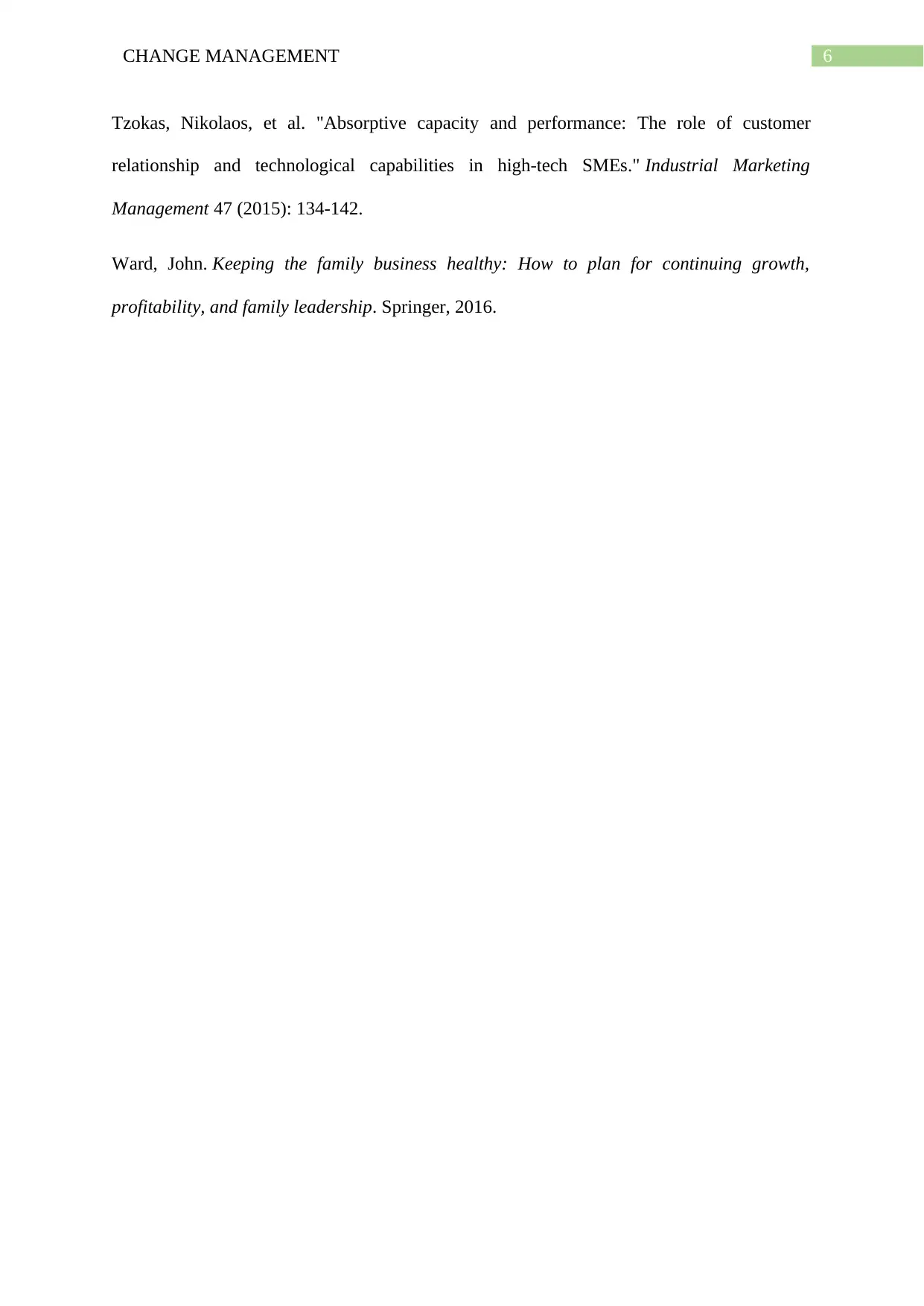
6CHANGE MANAGEMENT
Tzokas, Nikolaos, et al. "Absorptive capacity and performance: The role of customer
relationship and technological capabilities in high-tech SMEs." Industrial Marketing
Management 47 (2015): 134-142.
Ward, John. Keeping the family business healthy: How to plan for continuing growth,
profitability, and family leadership. Springer, 2016.
Tzokas, Nikolaos, et al. "Absorptive capacity and performance: The role of customer
relationship and technological capabilities in high-tech SMEs." Industrial Marketing
Management 47 (2015): 134-142.
Ward, John. Keeping the family business healthy: How to plan for continuing growth,
profitability, and family leadership. Springer, 2016.
1 out of 7
Related Documents
Your All-in-One AI-Powered Toolkit for Academic Success.
+13062052269
info@desklib.com
Available 24*7 on WhatsApp / Email
![[object Object]](/_next/static/media/star-bottom.7253800d.svg)
Unlock your academic potential
Copyright © 2020–2025 A2Z Services. All Rights Reserved. Developed and managed by ZUCOL.





